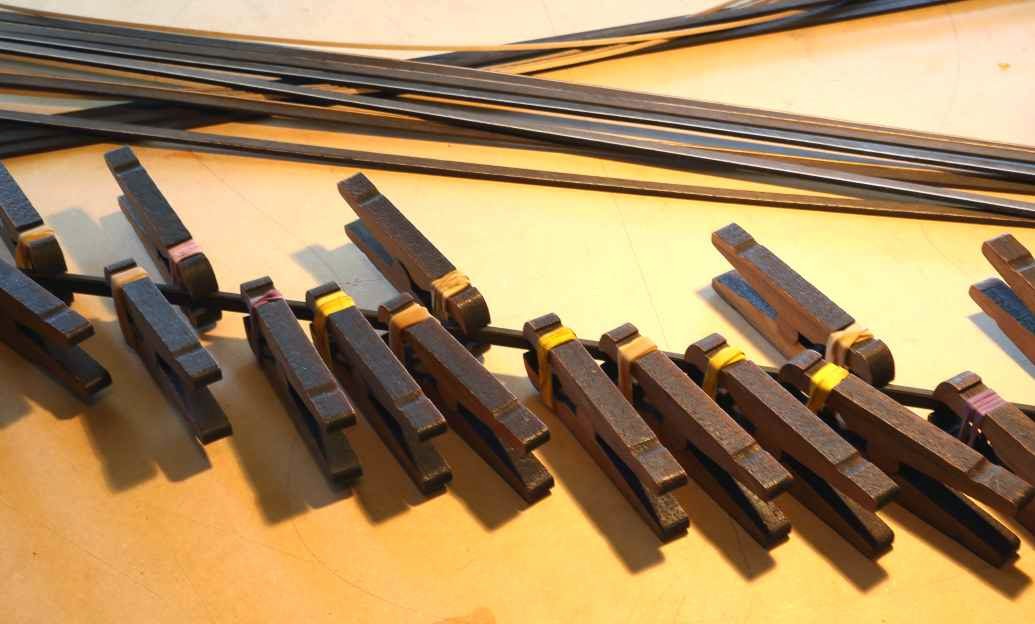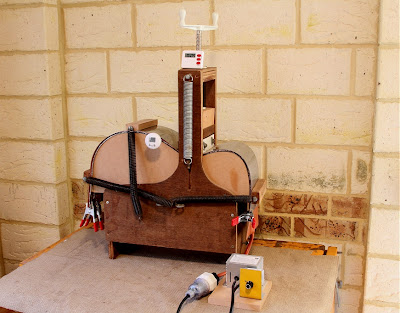I attach the black and white side purfling strips to the ebony bindings with Titebond 3, a glue that's much more resistant to heat and moisture than the regular Titebond I rely on for so many other guitar-building tasks. The clamps I use when gluing kerfed linings to the sides come in handy for this task too. If only I owned enough to prepare more than one binding strip at a time - tedious! Once the glue is dry, I scrape off any beads of glue and level areas where the edge of the purfling stands proud of the ebony bindings.
Ebony can be stubborn to bend and prone to breakage, particularly if there's run-out present in the binding strips; I always take the pessimistic approach and bend a few spares. In an effort to minimise breakages, I spray them with Super-Soft veneer softener the day prior to bending, and heat the bending blanket to a higher temperature than I'd use for more compliant woods. Although a little spring-back isn't the end of the world where bindings are concerned, I run them through two cycles of heating and cooling to help set the all-important waist bend. On this particular batch of 12 binding strips, I'm pleased to report that all 12 survived intact.
The use of ebony bindings might pose some difficulties in terns of bending, but it does at least provide some latitude when it comes to preparing close fitting joints. I do my utmost to achieve perfection, but usually miss the mark to a greater or lesser degree; fortunately, imperfections are easily disguised with ebony dust and a drop of thin CA glue.
The use of ebony bindings might pose some difficulties in terns of bending, but it does at least provide some latitude when it comes to preparing close fitting joints. I do my utmost to achieve perfection, but usually miss the mark to a greater or lesser degree; fortunately, imperfections are easily disguised with ebony dust and a drop of thin CA glue.
A short length of binding to which I've glued and mitered a piece of purfling is a useful aid when it comes to fitting the end graft. I carefully trim the ends of the end graft using a disc sander, frequently using the binding fragment as a substitute for the actual bindings as a means of checking progress as I sneak up on the final length. Only when I'm completely happy with the fit do I glue and tape the end graft into place. I know many builders trim the graft and miter its corners after it's glued in place but, as much as I'd prefer to avoid the situation, I like having the option of discarding a poorly prepared graft before I've committed glue to it. With the end graft successfully sized and glued in place, I can remove the appropriate length of side purfling from the actual binding strips, then miter the purfling ends to achieve a tight fit where they butt up to the end graft corners.
The point at which the bindings meet at the tail of the instrument is most commonly dealt with by simply butting the ends of the bindings together, but I find I'm more likely to achieve an invisible joint by introducing a matching 45 degree bevel to the end of each piece - commonly known as a scarf joint. The scarf joint is cut in such a way that the end of the binding glued on second wedges tightly under the end of the first. I treat the purflings in the same way. At their full length, the purfling strips extend well past the end graft, so I leave them intact and the location of the scarf joint therefore ends up somewhere other than the half-way point. It's perhaps because the joints aren't where you would expect to find them that they seem much more difficult to detect.
In the interests of achieving a snug fit when it comes time to install the bindings, I find it's helpful to have filed or sanded a facet onto their inner corners. I do the same to the top outer corner of the binding so that the filament tape I use to secure the binding as it's glued isn't cut by the sharp outer edge when force is applied to the tape. To avoid an ugly gap, I'm careful not to round over the top outer binding edge where it will intersect with the fretboard edge. With this in mind, I round over the binding edge in this area with the neck temporarily attached.
On the guitar pictured, which has a florentine cutaway, the curvature of the plates - the back in particular - is such that the sections of binding destined for the cutaway must curve in two dimensions. To achieve a neat, gap-free fit here, I've taken inspiration from the Ervin Somogyi book and fabricated two lengths of binding - one for the top, and one for the back - that have the necessary compound curvature.
To prepare them, I held a piece of stiff card against the inner surface of the cutaway and ran a pencil around the perimeter of the top and back plates; the resulting pencil lines described the curvature I needed to introduce into my ebony strips prior to bending them to match the shape of the cutaway. To make things easier on subsequent guitars, I've prepared a piece of 6mm MDF whose opposing edges conform to these curves. With an ebony headplate attached to the MDF template, a flush-trim router bit gives me a clean edge that's guaranteed to conform to the floor of the binding channels without the need to apply force that would distort the strips and cause gaps between the binding and the adjacent purfling.
Despite the fact that I sprayed the the first pair of strips with Super-Soft and left them to dry overnight, my attempt at bending them to conform to the curvature of the cutaway failed; evidently there was some run-out in my ebony stock, and both strips broke before I'd managed to make much headway. Plan B involved preparing four curved strips - two for the top and two for the back - again using the template pictured. I glued purfling to the edge of one of each of the pairs then, with the help of my drum sander, sanded all of the strips to a thickness representing a fraction more than half the width of the binding channels.
At a thickness of just over 1 millimetre, they bent easily even without the use of Super-Soft, and I was able to laminate the bent pieces to form the two full-width binding sections required. The ebony I used was perfectly black, and the fact that the strips are comprised of two layers will be undetectable once a finish is applied.
Perhaps an overlooked component of binding preparation is the mental aspect. Along with many other (most?) guitar builders, I don't particularly enjoy the task of binding a guitar, and I delay each step until I feel I'm a state of mind conducive to producing a good result. Fabricating and fitting the bindings to the point of the cutaway, for example, requires great patience and precision, and I make sure I'm relaxed but alert before I tackle the job.
Please feel free to offer suggestions and comments - the learning never ceases!
Useful links:
Super-Soft 2The point at which the bindings meet at the tail of the instrument is most commonly dealt with by simply butting the ends of the bindings together, but I find I'm more likely to achieve an invisible joint by introducing a matching 45 degree bevel to the end of each piece - commonly known as a scarf joint. The scarf joint is cut in such a way that the end of the binding glued on second wedges tightly under the end of the first. I treat the purflings in the same way. At their full length, the purfling strips extend well past the end graft, so I leave them intact and the location of the scarf joint therefore ends up somewhere other than the half-way point. It's perhaps because the joints aren't where you would expect to find them that they seem much more difficult to detect.
In the interests of achieving a snug fit when it comes time to install the bindings, I find it's helpful to have filed or sanded a facet onto their inner corners. I do the same to the top outer corner of the binding so that the filament tape I use to secure the binding as it's glued isn't cut by the sharp outer edge when force is applied to the tape. To avoid an ugly gap, I'm careful not to round over the top outer binding edge where it will intersect with the fretboard edge. With this in mind, I round over the binding edge in this area with the neck temporarily attached.
On the guitar pictured, which has a florentine cutaway, the curvature of the plates - the back in particular - is such that the sections of binding destined for the cutaway must curve in two dimensions. To achieve a neat, gap-free fit here, I've taken inspiration from the Ervin Somogyi book and fabricated two lengths of binding - one for the top, and one for the back - that have the necessary compound curvature.
To prepare them, I held a piece of stiff card against the inner surface of the cutaway and ran a pencil around the perimeter of the top and back plates; the resulting pencil lines described the curvature I needed to introduce into my ebony strips prior to bending them to match the shape of the cutaway. To make things easier on subsequent guitars, I've prepared a piece of 6mm MDF whose opposing edges conform to these curves. With an ebony headplate attached to the MDF template, a flush-trim router bit gives me a clean edge that's guaranteed to conform to the floor of the binding channels without the need to apply force that would distort the strips and cause gaps between the binding and the adjacent purfling.
Despite the fact that I sprayed the the first pair of strips with Super-Soft and left them to dry overnight, my attempt at bending them to conform to the curvature of the cutaway failed; evidently there was some run-out in my ebony stock, and both strips broke before I'd managed to make much headway. Plan B involved preparing four curved strips - two for the top and two for the back - again using the template pictured. I glued purfling to the edge of one of each of the pairs then, with the help of my drum sander, sanded all of the strips to a thickness representing a fraction more than half the width of the binding channels.
At a thickness of just over 1 millimetre, they bent easily even without the use of Super-Soft, and I was able to laminate the bent pieces to form the two full-width binding sections required. The ebony I used was perfectly black, and the fact that the strips are comprised of two layers will be undetectable once a finish is applied.
Perhaps an overlooked component of binding preparation is the mental aspect. Along with many other (most?) guitar builders, I don't particularly enjoy the task of binding a guitar, and I delay each step until I feel I'm a state of mind conducive to producing a good result. Fabricating and fitting the bindings to the point of the cutaway, for example, requires great patience and precision, and I make sure I'm relaxed but alert before I tackle the job.
Please feel free to offer suggestions and comments - the learning never ceases!
Useful links:
Kerfing Clamps
Cheers
Pete







































